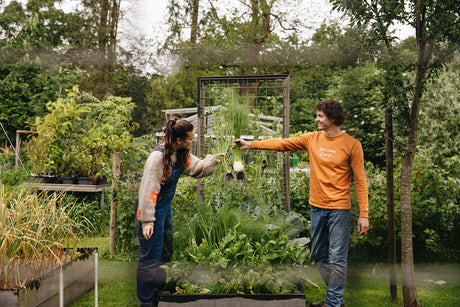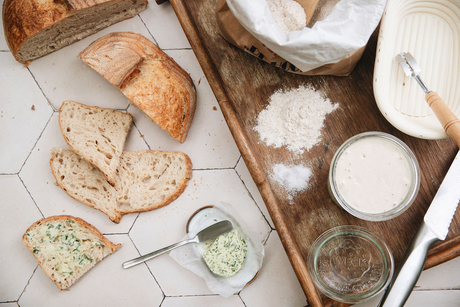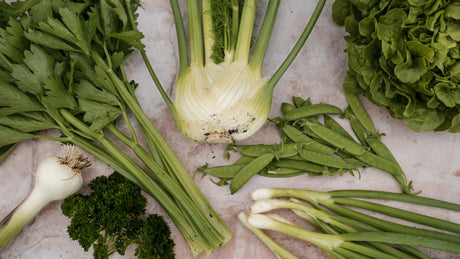Magnesium for a deep green leaf, the sun's rays do the rest
note in advance: For the sake of clarity '
Magnesium is not a growth substance' such as
nitrogen (N),
phosphorus (P) or
Potassium=Potassium (K) . The NPK substances ensure the growth of your plant. Nitrogen for leaf growth,
phosphorus for a strong root system and the strength of your plant and Potassium=Potassium for good fruits and also the strength of the plant. So NPK in the vegetable garden and that's it, right? No, not really. For the chemical processes within the plant you also need minerals such as calcium, copper, manganese, zinc, iron, ... in this article we talk about
Magnesium .

In the vegetable garden soil
Magnesium is a metallic chemical element that is vital to humans, animals and plants.
Magnesium is one of the thirteen mineral nutrients present in the soil. Dissolved in water, it is absorbed by the plant through the roots. When there are not enough minerals in the soil, it is necessary to fertilize to restore the balance of minerals, including
magnesium, in the soil.
Magnesium can be administered very efficiently in the form of
magnesium sulphate , Epsom salts or Epsom salts.
Magnesium is the workhorse behind the phenomenon of photosynthesis. Photosynthesis is a process in which (sun)light is converted into energy (sugars) for the plant. Without
magnesium, the chlorophyll in the leaves of the plant cannot absorb energy and cannot produce food for the plant and nitrogen or
phosphorus or potassium will not change that.
Magnesium is found in the enzymes, in the heart of a chlorophyll molecule. In short,
magnesium is essential for green leaves that get energy from the sun. Did you know that a plant gets 80% of its energy from (sun)light? Try growing a plant in the dark, the best
compost , the most expensive fertilizers and the best grower do not get a beautiful plant. Chicory is grown in the dark, but the roots are grown in the light with green leaves.

photosynthesis
In the article
The soil: The ABC of the vegetable garden soil you will learn more about organic material and what is present in a vegetable garden soil. A
magnesium deficiency occurs in poor soil, soil with little organic material. During heavy rainfall,
magnesium can be washed away from sandy or too acidic soil. When there is a lot of potassium (also called Potassium) in the soil, the plants absorb potassium rather than
magnesium . This is bad for the plant.
How can you tell if your plants have too little Magnesium ?
A
Magnesium deficiency
Magnesium can be seen when the older leaves of your plant quickly turn yellow around the veins and on the edges. Many people immediately think of too little water. But a
magnesium deficiency is much more often the cause. With a lack of water, the leaves become limp sooner. Purple, red or brown leaves also indicate a
magnesium deficiency. If you do not intervene, the leaves will die and eventually the plant too.

How to retain and apply Magnesium in your garden.
The best way to keep
Magnesium in your vegetable garden is to work rich organic
compost into your soil.
Compost retains moisture in the soil and prevents nutrients such as
Magnesium from washing away during heavy rainfall. The
compost not only protects against washing away, it also contains a lot of
Magnesium . Logical because
Magnesium is in almost all ingredients of the green waste that we process in our
compost .
Some people use chemical spray to spray on your leaves, but you are much better off working
Magnesium into the soil in the spring.
Eco Style's magnesium is a natural fertilizer and problem solver. It contains a high level
of magnesium and is rich in sulfur. The fertilizer ensures a better structure and fertility of the soil, restores brown discoloration and contributes to a healthy, strong plant. 1 handful (50 grams) per square meter is sufficient for a very fertile cultivation of all your crops that require green leaves. You can also save your plants when you notice
a magnesium deficiency. It quickly washes into your soil and is quickly absorbed by your plants. The
magnesium ensures a deep green leaf that converts the sun's rays into top food for your plants. Definitely worth trying with legumes, cabbage crops, fruit crops,
potatoes and of course leafy vegetables.
Magnesium can also be administered very efficiently in the form of
magnesium sulphate , Epsom salts or Epsom salts.

 photosynthesis
photosynthesis







